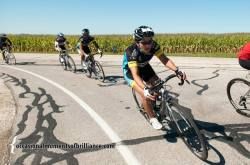No matter what type of athlete you are, you’re likely familiar with the concept of “matches” or “bullets” available for training and racing. The idea is that as athletes, there are a finite number of hard efforts that we can produce without suffering deleterious effects. Regardless of whether you are a criterium specialist or road racer, triathlete or time trialist, understanding what this concept means for you will help to optimize your training and racing performance.
The hardest part is defining what actually constitutes the use of these finite resources, also referred to as “burning a match.” The key component in the definition of a match is that submaximal exercise can be sustained nearly indefinitely with appropriate fueling. However, as effort increases up to and above threshold power, the time that an effort can be sustained decreases drastically and the actual physiological response experienced by the body increases exponentially.
As many of you have heard from Robbie, “Make the juice worth the squeeze.” This statement has a wide variety of implications, but in the present context we would want to make sure that any time you invest the effort to burn a match, that effort will result in improved performance in a race situation. The terrain, weather conditions and field on the day of your race can have major implications on the manner in which matches are used and successful racers will need to be prepared to adapt their strategy in order to maximize their racing outcome.
As a rule of thumb, you can get away with spending more matches for a shorter event than you can in a longer race. This is not to say that you can use your finite energy resources recklessly, but the benefit you gain will have a greater effect since it is affecting a larger proportion of the total race time. There is also less time in the race that you will have to suffer the adverse effects of your effort.
During longer races, as well as triathlon, you will need to be a little more conservative in terms of managing your resources. The effort you invest to climb a 90 second hill in 60 seconds, for example, will have a little bearing on your total time during a 5-6 hour Ironman bike leg. Further, it is likely to compromise your ability to produce sufficient power during the rest of the race, meaning spending that effort in the first place could ultimately slow you down.
For triathletes of any distance from sprint to Ironman, it is also important to assess the effects that burning matches on the bike will have on the run leg.
Initially it will be difficult to assess how vast your body’s resources are and what constitutes a “match” for you. Through experience and trial and error, you will be able to determine what level of exertion, or even better what power output, will send you past your limit. Remember to always consider if the effort you will invest is likely to result in a better performance or if that energy can be better spent in the field sprint, attacking to break away, or lifting your pace for the remainder of the event. Armed with that knowledge, you can go into a racing situation with a well-formulated plan and manage your reserves effectively to arrive at your desired outcome.

